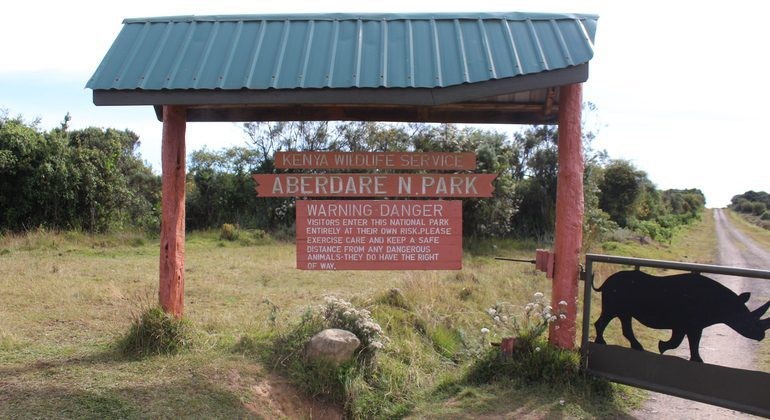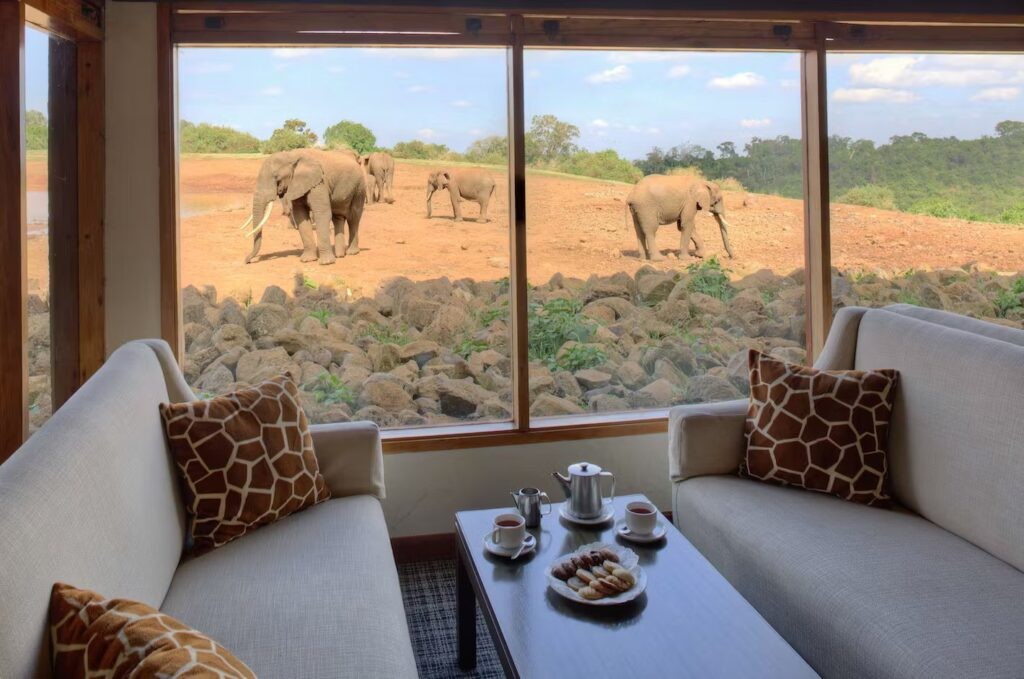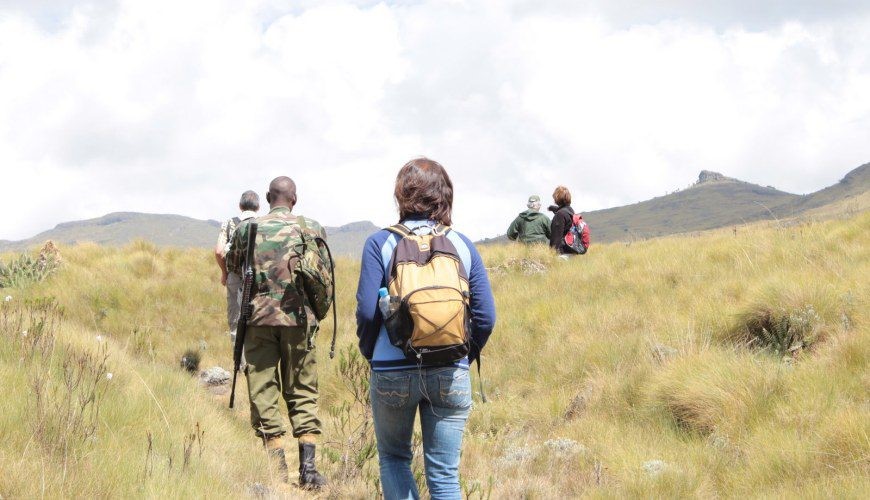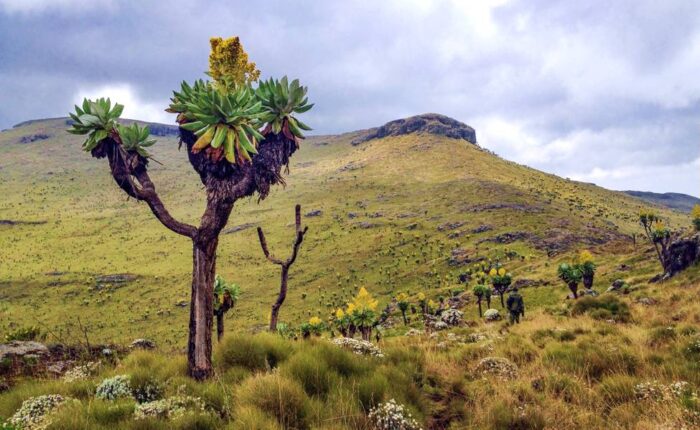Aberdare National Park Safari: The Park is a park situated about 100 km north of Nairobi and covers an area of just 766 km2 , stretching over a wide range of topography at altitudes ranging from 2 000 m to 4 000 m. The Park was established in May 1950 to protect the Aberdare Mountains and immediate wildlife forming part of the Aberdare mountain ranges. The ranges stretch from Nairobi in the East, to Nyahururu in the West; cutting through several administrative counties. The Aberdare Range straddles Nyandarua, Nyeri, Muranga Kiambu, and Laikipia counties. In short, the Aberdare range is about 160 km long. The park has a great stretch of alpine moorland vegetation, mainly above 3,000m.
The mountain ranges have two main peaks namely: Ol Donyo Lesatima (3,999m) and Kinangop (3,906m). Aberdare National Park forms a thick tropical forest, with deep ravines and dissecting riverine gorges. At certain areas, these rivers form majestic waterfalls, which leave a sight to be admired. Karuru Waterfalls are massive and fall in three steps (the 1st step at 117m, 2nd step 26m and 3rd step 130m. In total, it makes 273m. Another interesting one is Chania Waterfalls. There are also several other smaller waterfalls. The ranges encompassing Aberdare National Park are a major water tower in Kenya and form the catchments for Kenya’s two largest rivers- Tana River and Athi River.
Aberdare National Park Safari: Amazing Scenery

The mountain forms a section of the eastern rim of the Great Rift Valley, running roughly north to south. The west side falls steeply into Lake Naivasha and then Mau Escarpment, while the east slope is more gentle with views from peaks like Mount Kenya
Aberdare has a wide range of landforms and offers one of the best attractions. From mountain peaks that rise to 4,000 m above sea level to the deep v-shaped valleys crisscrossed by streams and rivers that surge down through the waterfalls to the low levels holding the moorlands, the rainforests as well as the bamboo forests. The rich, red volcanic soil provides the essential growing environment for the indigenous woodland, and lies in complete contrast with both the woodland and the mountain’s craggy and striking crests.
The Moorland and the alpine form a great source of major rivers that flow from Aberdares. Athi and Tana rivers drain into the Indian Ocean. The famed Dragons teeth is an excellent spot for Rock climbers and offers magical views
Aberdare National Park Gates

Aberdare National Park has got eight entry gates to access the park that includes the Ark, Treetops, Ruhuruini, Kiandongoro, Mutubio, Wandare, Rhino, Shamata gates.
By road, one takes the A2 road out of Nairobi via Thika in Nyeri then the Nyeri-Nyahururu road out of Nyeri where the Ruhuruini, Ark and treetops gates are sign posted.
By air, one can take a scheduled chartered flight and there are two good airstrips for chartered aircrafts at Nyeri and Mweiga, next to the Aberdare National Park headquarters.
Highlights of Aberdare National Park
- Moorlands and Alpine forests
- Wildlife and birdlife
- Major peaks, Kinangop- 3,905m to the south and Ol Doinyo Satima-3,995m to the north
- Waterfalls – Karuru falls, Chania falls and Gura falls
- Queens Cave
Things to do in Aberdare National Park
Safari drives for wildlife viewing and Bird watching: The Aberdare National Park is rich in flora and fauna. The park plays host to a wide array of wildlife and these include the Cape Buffalo, the African Elephant, the African Wild Dog, the Leopard, the Side-Striped Jackal, the Giant Forest Hog, the Eland, Duiker, Suni, Reedbuck, Bushbuck and Waterbuck, the Baboon, Black and White Colobus Monkey, Sykes Monkey. Rare viewings include those of the Bongo, an elusive forest antelope that dwells in the bamboo forest, and the African Golden Cat. Animals such as the spotted and melanistic Serval Cats and the Elands can also be seen on higher grounds in the moorlands.

The Park is also a known birdwatcher’s haven with more than 290 bird species that can be sighted including the Mountain Buzzard, the Sunbird, Jackson’s Francolin, the Goshawks, Ayre’s Hawk Eagles, Plover, the endangered Aberdare Cisticola, the African Fish Eagle and more.
Spotting Wildlife from your balcony in the Ark Lodge: The Ark Lodge offers guests a truly rare experience to observe wildlife since it is situated inside the Aberdare National Park. The lodge overlooks a waterhole with saltlicks to attract wildlife so they can be observed throughout the day from the comfort of the lodge. There are numerous decks, balconies, and lounges from which guests can watch the continuous comings and goings of animals around the waterhole. The floodlight also allows viewing throughout the night.

Trout fishing in Aberdare National Park: Trout fishing is one of the famous activities in the park, for which visitors generally reach the ice-cold Gura, Karuru and Chania Rivers.
Mountain Hiking in Aberdare National Park: Aberdare National Park hosts some of Kenya’s best moorland hiking trails. Aberdares trails are good preparation hikes, particularly if one planning a more challenging mountain climbing such as Mount Kenya or Mount Kilimanjaro. However, natural beauty and the splendor of distinct vegetation, indigenous trees, forest covers, Waterfalls, and rocks formation make Aberdare one of Kenya’s most beautiful places.

There are routes that allow you to hike a longer stretch to one of the Aberdares Peaks e.g. the Elephant Hill Hike -This is the most famous route on the Aberdare Ranges Hiking Tour. On these routes, you will drive to the base of the mountain range and then hike on foot to one of the peaks and back to the vehicle.
Other short hikes can be done more gently, such as the Karuru, Gura/ Magura and Chania Waterfalls hikes. On these waterfall hikes, you will drive slowly to the starting point as you enjoy wildlife viewing. You will then walk down to the waterfalls and then hike back to the vehicle.
The scenic hike towards the highest summit in Aberdare National Park, starts 12km beyond Rhino gate. During the drive up, it is possible to spot zebra’s, waterbucks, warthogs and other wildlife. The hike towards Satima summit at 4000m altitude takes 3 to 4 hours. The first two kilometers are through scrubland, after which the trail emerges on the moorland, which are protruded with imposing rock formations and is dotted with the Lobelia Keniensis, native to the alpine zones of Kenya. The most striking rock formation is colloquially known as ‘Dragon’s teeth’ and is reached after 5 kilometers. The trail runs through this rock formation, after which it is another 2 miles to the summit. On a clear day, it’s possible to see Mount Kenya from the summit. The descent back down is faster and it takes around 2 hours.
Le Satima Dragons Teeth Trail
Of all the trails in the Aberdare, The Dragons Teeth is the most beautiful mountain landform. Satima is an excellent spot for Hiking, Camping, and Rock Climbing in the famed Dragons Teeth Valley area.
How to get to Mount Satima via Dragon’s Teeth?
The entrance to the hike at Rhino gate is signposted on the Nyeri-Nyahururu highway It is a 11km drive from the highway to the KWS office at Rhino gate.
Mount Kinangop Trail
Also known as Ilkinangop, located in the southern Aberdare parent Range, about 160 km north of Nairobi, Kenya. It’s the second-highest mountain in the Aberdare ranges. Also the fourth-highest mountain in Kenya.
Elephant Hills Trail
The Elephant Hill hike is, without a doubt, the most popular trail in the Aberdare Range. The Elephant Hill hike earns different reactions from hikers that dare to attempt it. If you plan to hike elephant hill, it is paramount to get this information beforehand.
Aberdare National Park Entrance Fees
The entrance fee to Aberdare National Park is USD 52 per adult per day and USD 26 per child under 12 years old, per day.
| Citizens/Residents Adult | Citizens/Residents Child | Non-resident Adult | Non-resident Child |
| Ksh.300 | Ksh.215 | $52 | $26 |
Pay for your entry to any of our Parks or Reserves via eCitizen government platform.
Create a personal account on the eCitizen Government platform by visiting https://kws.ecitizen.go.ke and make park payments in advance for a fast and convenient park entry.
Best Time to Visit Aberdare National Park
The park experiences a cycle of rainy seasons and dry seasons. Mist and rain occur throughout much of the year, with precipitation varying from around 1000mm yearly on the north western slopes to as much as 3000mm in the south east.
The long dry season, which runs from July to October, is the best time to visit the reserve. This is the coolest season of the year, with an average temperature of between 21 degrees Celsius to 23 degrees Celsius during the day and 11 degrees Celsius during the night. Therefore, you should carry an extra layer of warm clothes for your morning and evening activities.
The short rains pour from November to December. These rains should not affect your activities as the moisture usually evaporates quickly.
The short dry, and humidly hot season runs from January to March with minimal rainfall.
The long rains kick in from April to May. This is the most challenging time to move around the park.
In late March and June, you might experience some light showers, but this is the begging of the best season for traveling to the Aberdare National Park.
From November to March, the average temperature varies from 21 degrees Celsius to 25 degrees Celsius during the day and 9 degrees Celsius to 11 degrees Celsius during the night.
Aberdare National Park Safari: Check some of our safari packages that will help you discover the best attractions in Aberdare National Park:
5 Days Aberdare Olpejeta and Samburu Safari

